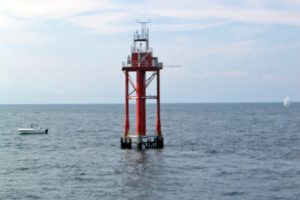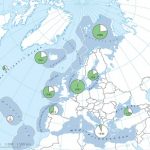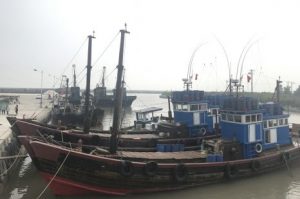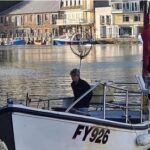The Whale slaughter continues, but is this just the beginning? By Jim Lovgren
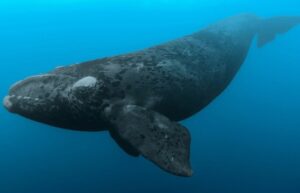 Another Humpback Whale washed ashore on a New Jersey beach on March 1 st , the 12th known Whale to die since the start of December, along the New York, New Jersey shoreline, coincident with multiple research vessels using active Sonar, seismic Pingers, and Ultra High Resolution Seismic sparkers. These are different types of equipment used to map the seafloor by Wind and oil companies, which emit loud sound pulses over 200 dBs continuously around the clock, that can travel hundreds of miles underwater.
Another Humpback Whale washed ashore on a New Jersey beach on March 1 st , the 12th known Whale to die since the start of December, along the New York, New Jersey shoreline, coincident with multiple research vessels using active Sonar, seismic Pingers, and Ultra High Resolution Seismic sparkers. These are different types of equipment used to map the seafloor by Wind and oil companies, which emit loud sound pulses over 200 dBs continuously around the clock, that can travel hundreds of miles underwater.
While the damage caused by Naval high powered active sonar, both mid and low frequency, is documented and admitted by the US Navy, the use of lower powered active sonar [both low and mid frequency] has not yet been linked to marine mammal strandings. Of course the US government has not funded any research into this issue, so that they can claim no evidence of a link between strandings and the use of this lower powered active sonar. Active Navy sonar operates at a level of 230 to 240 dBs one meter from its sound source and any unfortunate animal to be within 50 feet of operating Navy sonar will die a horrible death as its internal organs turn to mush by the powerful sound waves. The lower power sonar used by the research vessels creates sounds in the low 200 dBs range, which while not powerful enough to kill immediately, may kill indirectly due to its constant 24 hour a day usage, by a number of different boats within the New York Bight area. The government’s claim that there is no evidence that the research vessels noise-making sonar, or seismic sparkers are linked in any way to the recent Whale strandings, is being put to the test with each Whale death.
As more research vessels ply our waters, more dead Whales wash up on the beach. This is just the start of the gigantic ecosystem changing industrialization of the US continental shelf from the Gulf of Maine to Florida. The Biden administration’s stated goal of 30 gigawatts [GW] of offshore wind power by 2030 means that there will be over 3,400 individual wind turbines permanently occupying over 2,400,000 acres of ocean bottom. Once operational, they will form an imposing gauntlet of noise, vibrations, and electro-magnetic fields that marine mammals, turtles, fish, and birds will have to migrate through. This is especially critical in the area east of Rhode Island to south of Nantucket where the lease areas stretch from shoal waters to far offshore and has been designated as critical habitat for the endangered Northern Right Whale. If they want to avoid the noise of an operating wind farm they will have to swim in the inshore shipping lanes, where they suffer their most fatalities, or farther offshore
where food sources may be scarcer or even non-existent while having to navigate through the maze of offshore lobster and crab buoy’s.
In a recent Coast Guard notice to mariners for two CG districts in the New York bight it was announced; “TerraSond will be conducting geophysical survey activities within the Bluepoint Wind lease area [OCS-A 0537], 38 nautical miles [nm] off the coast of New York and 53 miles off the coast of New Jersey, from March 1 through September 30, 2023, 24 hours a day, seven days a week. Equipment on scene will be the GO Adventurer survey vessel, utilizing sidescan sonar, multibeam bathymetry echo sounder, cesium vapor magnetometer, parametric sub-bottom profiler, and ultrashort base line acoustic transceiver.”
There are dozens of these vessels and their support ships presently operating off the east coast all using high powered sonar and seismic equipment. The use of the dreaded seismic air guns has been replaced by the kindler, gentler Sparkers and pingers, which generate seismic sound by an electrical
charge as opposed to the air gun’s compressed air discharge. While the air gun arrays create noise at the 240 to 250 dBs level at the source, the sparkers noise is lower, operating in the 200 to 210 dBs range. Used in low frequency’s this sound can travel hundreds of miles in a spreading pattern which loses strength the farther from the source it travels. Since there are presently anywhere from 3 to 6 research vessels presently using either sonar or seismic equipment from Cape May to Nantucket Island it stands to reason that the complete continental shelf of the Mid Atlantic/Southern New England region is blanketed with some level of sonar or seismic noise. With other research vessels working from South Carolina, north into the Gulf of Maine the whole east coast is being blanketed by more underwater noise than ever before, all along the migratory paths of multiple endangered species.
Since marine mammals rely on hearing to feed, navigate, avoid prey, and mate, the intrusion of so much man made noise in such a short period of time is bound to be physically harmful to these sound sensitive animals. [read “Impacts of Navy sonar on Whales and dolphins : Now beyond a smoking gun? E.C. Parsons”] If a Whale is in an area where seismic or sonar is being used it will affect his ability to hear and communicate, and likely trigger a flight response, expending valuable fat reserves while doing so. An analogy; you and a friend go out to diner at a local restaurant that seats fifty people. There are six other people in the room at different tables and you and your friend can have a pleasant conversation. But as more people are seated the background noise starts getting louder, and you find yourself having to repeat statements because your friend can’t hear them. When the room is full, you can no longer hear each other from the accumulated amount of noise echoing from wall to wall. After sufficient noise
harassment, you ask for the check and leave. Whales don’t really have a way to leave their annual migratory path, its ingrained in them, and even small changes in a Whales migratory path can expend so much energy that it causes the animal physiological harm.
We now have 23 dead Whales on the east coast within a three month period, and despite what government officials claim, it is not a normal amount. A number of those deaths coincided with the operations of the RV Fugro Enterprise, which has multiple different sonar’s, and also features a GeoAcoustics 5430/5210 Sub Bottom Profiler, also known as a seismic pinger. The timing of strandings with the Fugro Enterprise operations has been documented by use of the AIS vessel tracking system. Presently geophysical surveying has been finished or is ongoing in about one third of the leased wind sites on the east coast.
When surveys in one area are completed, the research vessels move on to a different lease site, as the demand for these specialized vessels is presently intense. In their place come the construction crews, vessels, barges, jacking platform, ships, etc. all preparing for the loudest assault on the
environment, the pile-driving part, where a 150 to 200 ton hydraulic “hammer” is dropped onto the anchor pile, driving it repeatedly further into the seabed with each timed 250 dBs loud drop. One of the loudest man-made underwater sounds there is. Not to worry though, that sound will be mitigated, by a “Bubble curtain” which will trap the sound and reduce any harm to nearby animals, so say the bureaucrats who also claim no connection of sonar to the strandings. Regarding underwater sound mitigation techniques, quoting from, [Parsons et al, 2009] “It may be a long time before technology and methods are easily available to answer the many still unanswered questions about the exact nature and degree of the impacts of sound on cetaceans, especially when we know that many of the mitigation measures in place for protecting cetaceans against the impacts of sound are untested “best guesses” or indeed, are known to be ineffectual.”
While the pile driving is going on, the sea bed will be carved into trenches so they can bury 6,800 miles of undersea high voltage cables which connect the turbines to the substations and then to shore, utilizing a whole other type of construction vessel and further increasing vessel traffic. Eventually some of the turbines will start working introducing a new sound, plus the vibrations of the turbine itself into the marine environment. Electro- magnetic fields will be created around the turbines, substations, and the buried cables under the seabed which will affect benthic animal movements and migrations. This will go on for decades. The slaughter has just begun.




































